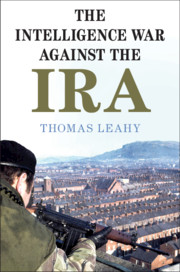Book contents
- The Intelligence War against the IRA
- The Intelligence War against the IRA
- Copyright page
- Dedication
- Contents
- Acknowledgements
- Abbreviations
- Introduction
- Part I The Intelligence War: August 1969 to July 1972
- Part II On the Verge of Defeat? The Intelligence War: July 1972 to December 1975
- 4 British Political, Military and Intelligence Strategy towards the IRA: July 1972 to December 1975
- 5 The Intelligence War: July 1972 to December 1975
- 6 ‘Everything Is Compromisable after the British Declaration of Intent’: The IRA Returns to Ceasefire, December 1974 to December 1975
- Part III The Struggle to Contain the IRA: January 1976 to April 1998
- Book part
- Notes
- Bibliography
- Index
4 - British Political, Military and Intelligence Strategy towards the IRA: July 1972 to December 1975
from Part II - On the Verge of Defeat? The Intelligence War: July 1972 to December 1975
Published online by Cambridge University Press: 05 March 2020
- The Intelligence War against the IRA
- The Intelligence War against the IRA
- Copyright page
- Dedication
- Contents
- Acknowledgements
- Abbreviations
- Introduction
- Part I The Intelligence War: August 1969 to July 1972
- Part II On the Verge of Defeat? The Intelligence War: July 1972 to December 1975
- 4 British Political, Military and Intelligence Strategy towards the IRA: July 1972 to December 1975
- 5 The Intelligence War: July 1972 to December 1975
- 6 ‘Everything Is Compromisable after the British Declaration of Intent’: The IRA Returns to Ceasefire, December 1974 to December 1975
- Part III The Struggle to Contain the IRA: January 1976 to April 1998
- Book part
- Notes
- Bibliography
- Index
Summary
Between July 1972 and February 1974, the British Conservative government focused on creating a power-sharing settlement with the constitutional parties. In the meantime, the security and intelligence services would try to reduce IRA activity to a level at which it could not obstruct the power-sharing government. But once the power-sharing executive collapsed in May 1974, the British government's political policy radically shifted. Between May 1974 and December 1975, the British Labour government under Harold Wilson and Merlyn Rees envisaged an agreement on Northern Irish independence between Irish republicans, Ulster loyalists and others as being possible. This idea was not irrational. Various leading IRA and UDA members had demonstrated a willingness to contemplate an independent six-county Northern Ireland. Nonetheless, the Labour government refused to give the public or private declaration of intent to withdraw that the IRA wanted. The British feared that any declaration would provoke a loyalist uprising and civil war. The ceasefire collapsed as the IRA was not willing to forgo a British declaration of intent to withdraw. Nevertheless, the British Labour government under Harold Wilson had been willing to explore withdrawal from Northern Ireland, if republicans and loyalists could agree to independence.
- Type
- Chapter
- Information
- The Intelligence War against the IRA , pp. 63 - 80Publisher: Cambridge University PressPrint publication year: 2020



